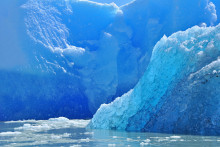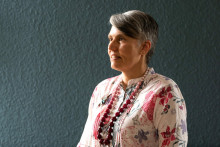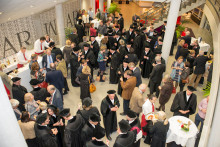The lecture, organized within UT´s Week of Inspiration, was given by Frans-Jan Parmentier, expert in Arctic research from Lund University in Sweden. Working in Svalbard, Siberia or Greenland, Parmentier sees the changes in arctic areas first hand and he understands the possible consequences of global warming, an undeniable issue that is already affecting the planet.
'Last year was the warmest year on record. The global temperature has increased by 1°C compared to the pre-industrial era,' began Parmentier. 'Because of this warming, all types of ice are melting. Land ice is melting, which leads to icebergs breaking off into the sea and sea level rising. If this continues, there will be about 1 meter of sea level rise by the year 2100. If that happens, Bangladesh will have to evacuate 25 million people.'
Decline in sea ice
There is also decline in sea ice. The amount of sea ice lost since 1979 is equal to the size of the European Union. This leads to more open water in the Arctic, which means problems for polar bears, but could also lead to new transport routes. That might not sound too bad, at least not for us who are far away from the sea (and polar bears). However, changes in sea also affect adjoining land. Sea ice loss leads to more evaporation, and therefore to more rain and snowfall.
The rise in temperature in arctic areas also influences jet streams, fast flowing air currents in the atmosphere, that are essentially responsible for weather all over Earth. Due to warming, these streams get stuck and bring cold air to otherwise mild climate. Last year, for example, there was no snow in Alaska, while New York City suffered from extreme cold for a rather long period of time.
Methane
Among other things, Frans-Jan Parmentier studies changes in permafrost. Permafrost is defined as soil that is frozen for at least two years in a row. It can be hundreds of meters thick and is found in many inhabited areas. 'Lately, we can see permafrost warming and disintegrating. This leads to cracks in roads, sink holes and even houses collapsing. Vegetation is also affected, trees lose their stability and create so called drunken forests,' described Parmentier. 'On top of that, permafrost holds a lot of carbon, which microorganisms can transform into methane and make the warming even worse.'
Morality vs. economy
'Methane is not a fast problem, though,' concluded Parmentier. 'The maximum global warming due to methane is 0.1°C by the year 2050. The real problem is the carbon we put into the atmosphere. If we continue like this, we will increase the global temperature by 2°C within 30 years.'
How can we change this? 'Right now there is a power struggle between the economy and morality,' answered Parmentier. 'I think that if people realize that growing economy and greener economy are not contradictory, the real changes will happen. Saving the planet must become profitable.'







